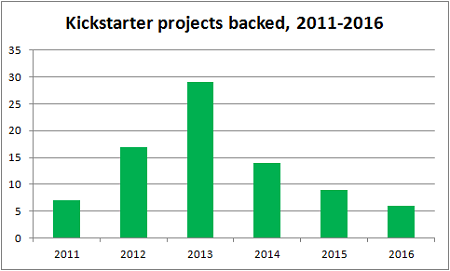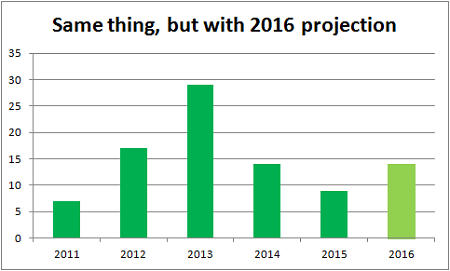Yesterday I was thinking about Kickstarter and how happy I am with some of the stuff that’s come in the mail this year, and I realized I should revisit a post I made on Google+ back in January — one that prompted some great discussion — and see if it still applied. It does, so I’m reprising it here on Yore.
I’ve been backing stuff on Kickstarter since 2011, and over the past five years my engagement with the site — and the “culture” of Kickstarting stuff, particularly tabletop RPGs — has changed. I’ve backed 82 projects as of this writing, mainly tabletop RPGs but also a couple of movies, some comics, several board games, and a few one-offs in other areas
These are my personal guidelines (not rules!) — a sort of informal sniff test that helps me decide whether to back a project. Some are weird, some may not apply to anyone else, and some I consider best practices.
No board/card games
I’ve kept just one board game I backed on KS, Swords & Strongholds — and I haven’t played that one yet. I have enough board games, and my track record in this area is terrible.
No FC0B
“First created, zero backed” is one of the biggest canaries in the Kickstarter coal mine, a big ol’ red flag that the project creator has no fucking clue what they’re doing. Granted, most gaming projects I’d consider backing don’t fall into this trap, and most gaming FC0Bs suck in all sorts of other obvious ways. I mind the 0B a lot more than the FC; everyone has to have an FC, after all.
No at-cost fulfillment
I totally get why offering backers an at-cost copy on DTRPG or Lulu, rather than handling fulfillment directly, is great for creators. But if I have to take the risk of giving you my money up front, I expect you to keep that skin in the game. It’s also inconvenient for me to have to essentially preorder, then order again; I’ll just order once, if the project succeeds, at zero risk to my wallet.
No spreadsheets
If I need a spreadsheet to figure out which reward level to choose, I’ll pass. I don’t feel like investing that much time in what’s essentially a preorder, and it can be a sign of excessive complexity in the project itself, leading to delays and other problems.
No paid autographs
It’s cool if you want to charge for signatures, but paying extra for one has zero appeal for me. I won’t avoid a project for having this option, I’ll just back it at a different level.
There must be a print option
I don’t read PDFs unless I have to, and I don’t back projects without a print book available.
Have your shit mostly done
This mainly applies to gaming books, and comes back to skin in the game. If all you have is an idea, whoopdedoo. I have lots of ideas, everyone has lots of ideas, fuck your idea. Write the damned book. If you can’t invest capital, invest time and energy and then start the KS. I make rare exceptions to this rule for people/companies whose work already lines my shelves; I know they’ll deliver.
Have actual risks and challenges
Don’t be cutesy (“The only risk is if I get hit by lightning!”), don’t boast about how many years you’ve been gaming (which has fuck-all to do with your ability to shepherd a project to completion), don’t say there are no risks. Do mention past projects, realistic hurdles, third party involvement (e.g., printers), and things like impending parenthood. Disclosure is good.
Limited clutter
The best stretch goals make the product better for everyone, and reward backers for taking a risk on your thing. Doodads, which generally involve additional parties and workflows and production hassles, can die in a fire. Make the thing better, and have a plan for wild success (i.e., some stretch goals in mind).
Some sort of sample
If I’m on the fence, being able to see part of the thing for free will help me get off the fence. If I don’t know you or your work, I probably won’t back without a pretty robust sample — a chapter, a draft, some excerpts, whatever.
My stats
Here are my Kickstarter backing stats by year, including 2016 to date:

Projecting a simple trend (average of 1.2 projects backed/month in 2016 so far) through the end of the year, it looks a bit different:

Those charts look like me mostly eating my own dog food[1] — there’s a board game project on my 2016 list, for example (one with a previous KS and a great track record, and I like the first set) — but it also looks like I’m headed for an uptick in backing stuff this year.
My guidelines have helped me choose KS projects better-suited to me, and that’s upped my confidence in backing things this year. I’ve passed up some fantastic-looking games because they only offered at-cost POD fulfillment, and I’m okay with that; I can always buy them later. I’ve ignored a host of gorgeous board and card games, and I’m okay with that, too.
I also tend to star instead of backing right away. I star, come back when the reminder lands in my inbox, and wind up backing maybe 10% of projects I’ve starred at that point.
There’s so much out there on KS now, especially in the RPG world, that I don’t even visit the site to browse anymore. Instead, I let my G+ stream be my filter, and generally only check out stuff I see other folks mention. That keeps the volume fairly manageable, and so far it seems to work.
[1] Guidelines, not rules!

Great guidelines. The FC0B guideline is one I will have to remember. Thanks!
Thanks!
Not everyone agrees the FC0B is a red flag, but it’s served me well.
I’m about done with board games myself, and I was turned off by the Ghostbusters game from last year…the achievement levels added new characters and minis to the game at too high a cost…I know I don’t HAVE to get everything but I would feel I didn’t have a complete game…and when my initial $80.00 backing ballooned into over 200, I had to pull out before my wife found out how much money I was spending…!
If I were stretching “no board games” to be something other than a purely personal guideline, it would be based on the fact that there can be a LOT of moving parts involved in making a board game. That’s easy to fuck up.
The KS exclusive thing is a big turn-off for me, too.
Great stuff and good advice. I’ve been trying to have all of my stuff done-and-paid-for before I even launch; prolly a big risk for me early on, but the hope is that after a few projects where people get their stuff within 4 weeks of the end of the Kickstarter, folks will be more willing to back bigger/riskier endeavors with longer fulfillment timelines.
That approach has worked well for a lot of the KS creators I respect, whose work I generally back as soon as it pops up. It’s a solid approach.
Good luck with your KS!
My plan is to have all the text of the game written, edited at least by me if not a professional, and again, indexed by me if not a professional. I’ll have layout done, and public domain or donated art in place. The Indiegogo/Kickstarter will be an upgrade. Better cover, better art, better indexing and editing by known pros, and ideally, enough pre-order strength to justify a real print run that gives a better book for less money than POD.
We’ll see. It will be, after all, my first rodeo.
Also a great approach! “It’s already good, let’s get together and make it even better” is a solid pitch.
I also have to believe (though I may be mistaken) that a real-press run of 2,000 vs Lulu would be a win-win. Cheaper per-book print costs, which means the author can turn a bit more profit AND the buyer gets a cheaper book. Not sure magnitude, though.
Depending on what you’re going for, Createspace has some definite advantages over Lulu. Lulu is amazing for on-demand hard-covers with undeniably good quality, but it’s hard to beat 2.15 per copy of any dimension soft-cover up to 108 pages from Createspace. Plus they have cheaper shipping and quicker fulfillment. Depending on the size of your game, though, Lulu’s about one of the few places that’ll do saddle-stitch, which is, frankly, wonderfully useful for tabletop game books, provided you’re going the 80s folio route and not a DCC doorstopper.
Thanks!
Also, dropshipping is a pretty huge advantage. It’s easier to hand-enter shipping info and pay a couple extra bucks per copy than try to handle shipping yourself. i’ve still got a spare room filled not only with unsold product from my record label days but also boxes of unused shipping materials wasting space.
On that topic, I haven’t used DriveThruRPG for that, but others do and it seems to go well.
I have used (still use) the same printer, and Lightning Source is an option worth considering. Price-wise, it’ll shake out somewhere between Lulu and an offset print run. which is the zone where my risk:cost ratio feels right to me.
One of my contributors who owns a few comic stores and publishes his own line of graphic novels recommended Lightning Source to me. Apparently he was one of their first graphic novel clients when they were beginning to expand their publishing business. I’ve been meaning to check them out, so it’s good to hear another recommendation for them.
All of the books I publish (Engine Publishing) are printed through Lightning Source, 2010 to present. I’ve always been happy with them.
One of my red flags is “excessive stretch goals”. If a project for one game book does really well, and the creator has multiple more books as stretch goals, suddenly they owe a dozen books to the backers and that is a lot more time and money then anyone actually has.
Yup. Make the thing better > make more things.